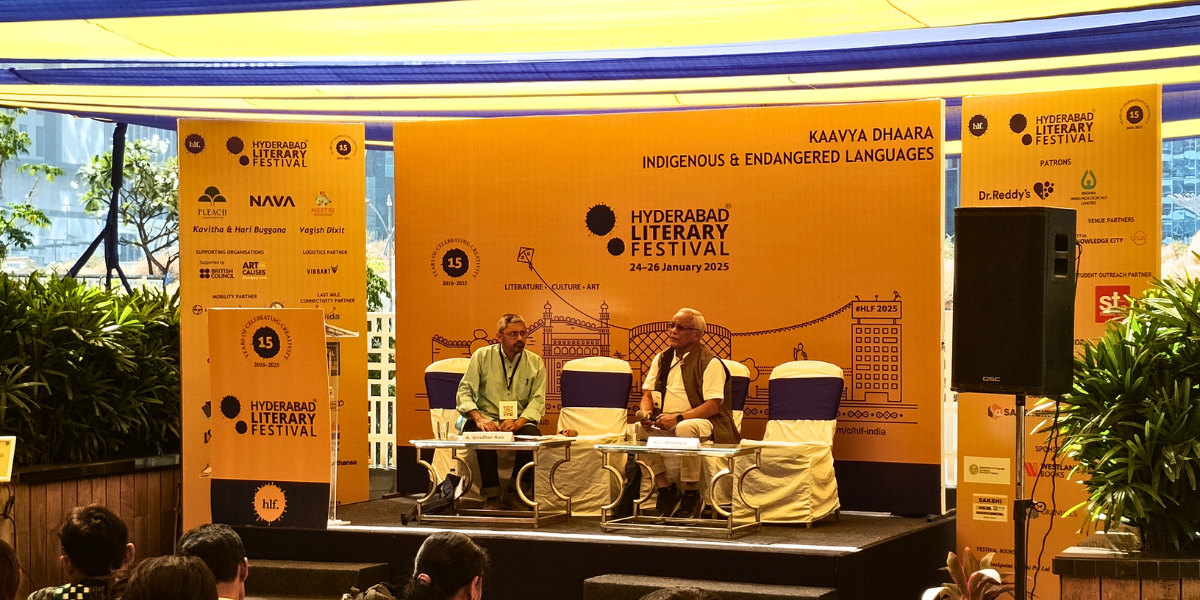Schooling in the mother tongue offers children a relatively easier start in education, and results often in greater proficiency even in picking up new languages.
Published Jan 27, 2025 | 9:09 AM ⚊ Updated Jan 27, 2025 | 9:09 AM

A Mohanty discussed whether schools can save mother tongues, indigenous languages in India
The Hyderabad Literature Festival kicked off on 24 January at the Sattva Knowledge City. Among the plethora of events and sessions, one held outdoors threw light on indigenous languages.
Ajit Mohanty, a former JNU professor, spoke about his work to revive and integrate indigenous languages in Indian schooling.
“No language dies naturally, it is killed,” he stated, revealing that over 16 languages died in the last 25 years in India.
He noted that this is not an isolated phenomenon; it is estimated, he said, that a language disappears off the face of the earth every two weeks.
Mohanty was among the pioneers who brought Multilingual Education (MLE) to Odisha in the 2000s.
He noted from his research on indigenous communities in the Northeast and Odisha that the threat of extinction of languages makes it necessary to include one’s mother tongue in early education.
“When the children we worked with were exposed to education in their mother tongue, they did better as a whole. It improved their prowess not only in other subjects but also in the acquisition of a new language,” he explained.
He further noted that this was the positive effect schooling in the mother tongue until the fifth class could have.
Subsequently, Mohanty narrated a story close to his heart.
“Many years ago, when we were working on MLE with Gondi communities in Odisha’s Sawara, the parents were unwilling to send their kids to school. We had to convince them to give it a chance. Among our students was six-year-old Panchu,” he began.
“Panchu had to walk four kilometres through the forest to be able to attend school. He would walk every day with some older kids to receive an education in his mother tongue, Koya,” he said.
“One day, little Panchu was attacked by a hyena on his way to school. The hyena tried to drag Panchu into the forest, but the boy struggled with all his might and escaped,” he said.
At the time, Mohanty was not in Sawara. The professor received news of the wild animal attack and set about ensuring that Panchu had access to the hospital. He monitored the situation closely.
“I told the teachers to not insist on Panchu’s return to school. I did not want him to relive that trauma. However, just a couple of weeks later, I got a call. “Panchu is at school,” they said. He became an icon in my journey,” Mohanty recalled, with tears in his eyes.
“The tribal communities of Odisha hold weekly markets. However, they do not talk in Odia there, they speak in their mother tongue, Koya,” Mohanty explained.
He elaborated that speaking in their mother tongue allowed the women, the shopkeepers, to have the last word.
“Now, the women there speak in the dominant language, they do not have the last word,” he further explained.
To Mohanty, this was the denial of a human right.
“Their loss of language means a loss of identity. That in turn undermines their economic rights,” he said.
He referred to his research which projected that a community’s loss of language is often correlated with economic deterioration.
Mohanty used this to segue into a discussion of global phenomena.
“India is the world’s fourth most linguistically diverse country. However, it is also the country with the most endangered languages,” he noted.
He added that a contributing factor to this situation was the establishment of unnatural linguistic hierarchies.
“Who decides which is the dominant language; how do you decide something is a Scheduled Language?” he asked.
“Even attempts to integrate the languages in Indian schooling are met with a sort of bureaucratic murder. It has reached a point where parents are choosing to not insist on children learning their mother tongue since these languages are seen as detrimental to the child’s future,” he said.
The Right to Education Act, 2009, states that as far as is practicable, the medium of instruction will be the child’s mother tongue. The National Education Policy, 2020, also provides for instruction in the mother tongue at least up to Class 5.
Despite these enlightened statements of policy, the reality on the ground is that education in the English medium is preferred; even government schools in some states now attempt to offer education in the English medium.
(Edited by Rosamma Thomas)
